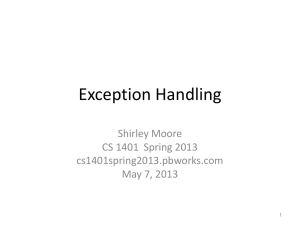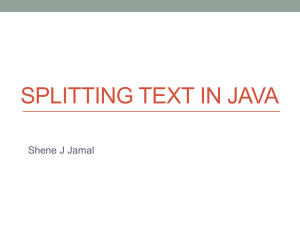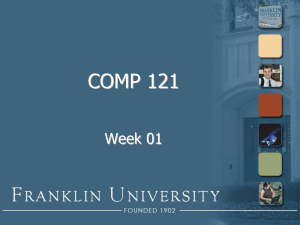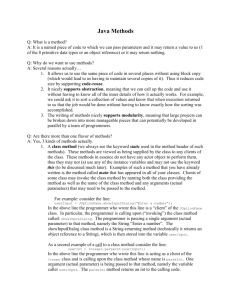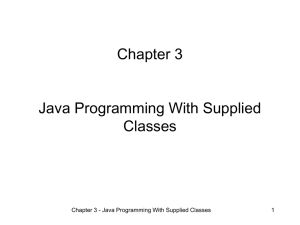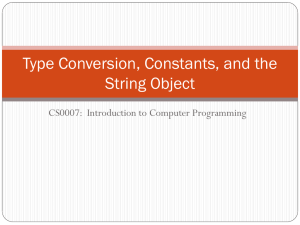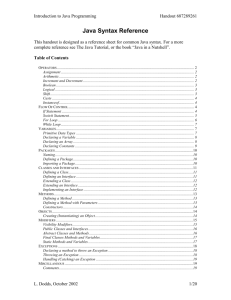Methods in Java - SercanUzumcu.com
advertisement
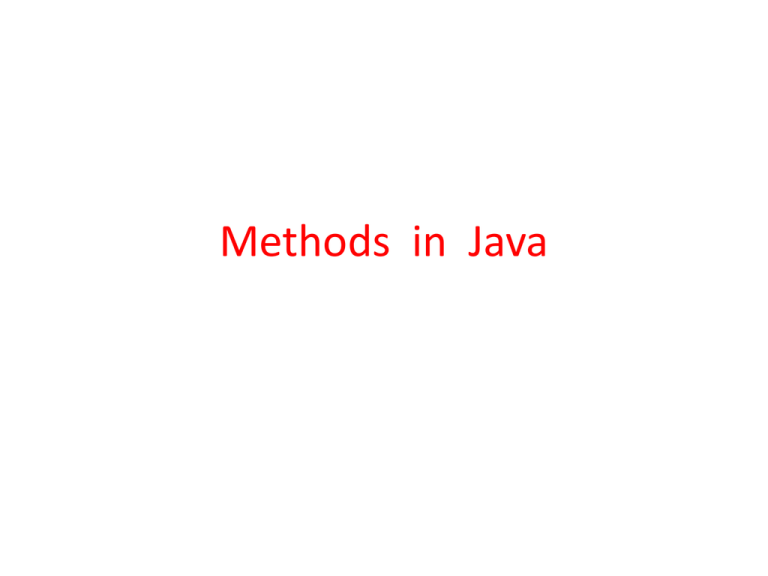
Methods in Java
Program Modules in Java
Java programs are written by combining new
methods and classes with predefined methods
in the Java Application Programming
Interface (Java API or Java class library) and in
various other class libraries
Related classes are grouped into packages so
that they can be imported into programs and
reused
Predefined Classes
of the Java API
methods for performing common mathematical
calculations
string manipulations
character manipulations
input/output operations
database operations
networking operations
file processing
error checking
and more.
http://docs.oracle.com/javase/7/docs/api/
static Methods
Sometimes a method performs a task that does not
depend on an object.
Such a method applies to the class in which it’s
declared as a whole and is known as a static method or
a class method.
To declare a method as static, place the keyword static
before the return type in the method’s declaration.
For any class imported into program, call the class’s
static methods by specifying the name of the class
followed by a dot (.) and the method name
ClassName.methodName(arguments)
Math Class Methods as a static method
Math Class Methods as a Static Method
Class Math provides a collection of methods that
enable you to perform common mathematical
calculations.
all Math class methods are static
Each is called by preceding its name with the class
name Math and the dot (.) separator
Class Math is part of the java.lang package,
it is implicitly imported by the compiler
it’s not necessary to import class Math to use its methods.
System.out.println(Math.sqrt(900.0));
static Variables
There are variables for which each object of a
class does not need its own separate copy
Such variables are declared static
They are called as class variables.
When objects of a class containing static
variables are created, all the objects of that
class share one copy of those variables.
Together a class’s static variables and instance
variables are known as its fields.
A Kind of Variable in Java:
Class Variables (Static Fields)
A class variable is any field declared with the
static modifier;
Tells the compiler that there is exactly one copy
of this variable in existence, regardless of how
many times the class has been instantiated.
The keyword final could be added to indicate
that the value of the class variable will never
change.
Other Kind of Variable in Java
Instance Variables (Non-Static Fields)
Objects store their individual states in "nonstatic fields"
Fields declared without the static keyword.
Non-static fields are also known as instance
variables
Their values are unique to each instance of a class
(to each object)
Another Kind of Variable in Java
Local Variables
A method will often store its temporary state in
local variables.
The syntax for declaring a local variable is similar
to declaring a field .
int count = 0;
There is no special keyword designating a variable
as local
determination comes from the location which is
between the opening and closing braces of a method.
Local variables are only visible to the methods in which
they are declared
they are not accessible from the rest of the class.
Another Kind of Variable in Java :
Parameters
public static void main(String[] args)
The args variable is the parameter to the method.
The important thing to remember is that
parameters are always classified as "variables" not
"fields”
This applies to other parameter such as
constructors and exception handlers.
Example
public class Bicycle {
……..
private static int numberOfBicycles = 0;
…………
public static int getNumberOfBicycles()
{
return numberOfBicycles;
}
………….
}
Referring Class Variables
Class variables are referenced by the class name
itself
Bicycle.numberOfBicycles
This makes it clear that they are class variables.
It is also possible to refer static fields with an object
reference
myBike.numberOfBicycles
but this is discouraged because it does not make it
clear that they are class variables.
Static Methods
A common use for static methods is to access static fields.
Not all combinations of instance and class variables and
methods are allowed:
Instance methods can access instance variables and instance
methods directly.
Instance methods can access class variables and class
methods directly.
Class methods can access class variables and class methods
directly.
Class methods cannot access instance variables or instance
methods directly
they must use an object reference
class methods cannot use the this keyword as there is no
instance for this to refer to.
Constants
The static modifier, in combination with the final
modifier is used to define constants.
The final modifier indicates that the value of this
field cannot change.
static final double PI = 3.141592653589793;
Constants defined in this way cannot be
reassigned, and it is a compile-time error if the
program tries to do so.
Why is method main declared
static?
Declaring Methods with Multiple
Parameters
// MaximumFinder.java
// method is declared with maximum with three double parameters.
import java.util.Scanner;
public class MaximumFinder
{ // obtain three floating-point values and locate the maximum value
public static void main(String[] args)
{ // create Scanner for input from command window
Scanner input = new Scanner(System.in);
// prompt for and input three floating-point values
System.out.print( "Enter three floating-point values ");
double number1 = input.nextDouble(); // read first double
double number2 = input.nextDouble(); // read second double
double number3 = input.nextDouble(); // read third double
// determine the maximum value
double result = maximum(number1, number2, number3);
System.out.println("Maximum is: " + result); // display maximum value
} // returns the maximum of its three double parameters
public static double maximum (double x, double y, double z)
{
double maximumValue = x;
// determine whether y is greater than maximumValue
if (y > maximumValue)
maximumValue = y;
// determine whether z is greater than maximumValue
if (z > maximumValue)
maximumValue = z;
return maximumValue;
}
} // end class
Enter three floating-point values 9.35 2.11 5.91
Maximum is: 9.35
Keywords public and static
Method maximum’s declaration begins with
keyword public to indicate that the method is
“available to the public”
it can be called from methods of other classes.
The keyword static enables the main method to
call maximum without qualifying the method
name with the class name MaximumFinder
static methods in the same class can call each other
directly.
Any other class that uses maximum must fully
qualify the method name with the class name.
Method maximum
The maximum method requires three double
parameters (x, y and z) to accomplish its task
When maximum is called the parameters x, y and z are
initialized with copies of the values of arguments
number1, number2 and number3, respectively.
each argument must be consistent with the type of the
corresponding parameter
There must be one argument in the method call for
each parameter in the method declaration
When program control returns to the point in the
program where maximum was called, maximum’s
parameters x, y and z no longer exist in memory
Important
Methods can return at most one value, but the
returned value could be a reference to an object
that contains many values.
Variables should be declared as fields only if
they’re required for use in more than one
method of the class or if the program should
save their values between calls to the class’s
methods.
Implementing Method maximum by
Reusing Method Math.max
The entire body of our maximum method could also be
implemented with two calls to Math.max, as follows:
return Math.max(x, Math.max(y, z));
The first call to Math.max specifies arguments x and
Math.max(y, z).
Before any method can be called, its arguments must be
evaluated to determine their values.
If an argument is a method call, the method call must be
performed to determine its return value.
Then the result is passed as the second argument to the other
call to Math.max, which returns the larger of its two
arguments.
Assembling Strings with String
Concatenation
Java allows you to assemble String objects into
larger strings by using operators + or +=.
This is known as string concatenation.
When both operands of operator + are String
objects, operator + creates a new String object in
which the characters of the right operand are
placed at the end of those in the left operand
the expression "hello " + "there" creates the String
"hello there«
the expression "Maximum is: " + result
uses operator + with operands of types String and
double.
Assembling Strings with String
Concatenation
Every primitive value and object in Java can be
represented as a String.
When one of the + operator’s operands is a String, the
other is converted to a String, then the two are
concatenated.
System.out.println ("Maximum is: " + result);
The double value is converted to its String
representation and placed at the end of the String
If there are any trailing zeros in a double value, these
will be discarded when the number is converted to a
String
for example 9.3500 would be represented as 9.35.
